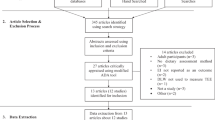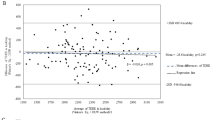Abstract
Objectives: To compare the estimated food diary record (ED) method against weighed intake record method (WI) for assessing dietary intake in infants and children aged 6–24 months; additionally, to compare WI with metabolisable energy intake (ME) measured by doubly labelled water (DLW) in infants aged 6–12 months.
Design: Cross-over study of 5 day WI vs 5 day ED.
Subjects: Seventy-two children aged 6–24 months.
Methods: Subjects were randomly assigned to one method during week 1 crossing over to the alternative method in week 2. Data were coded and translated into daily nutrient intakes using COMP-EAT version 5 nutritional analysis software. The analysis compared energy, protein, fat and carbohydrate. Twenty-one infants were dosed with DLW for measurement of total energy expenditure (TEE) and ME.
Results: Mean energy intake calculated from WI and ED was 3782 and 3920 kJ/day, respectively. There was no significant difference between these values. Using WI as a reference, ED showed a mean bias of 138 kJ/day, equivalent to 3.6% of mean energy intake. Limits of agreement (±2 s.d. of the bias) were wide at±1385 kJ/day. There were no significant differences between methods for any of the nutrient sub-classes. Using DLW as a reference, WI showed a mean bias of 243 kJ/day, equivalent to 7.3% of mean energy intake, limits of agreement were wide at ±1686 kJ/day.
Conclusion: There is no evidence from the present analysis that ED is less accurate than WI for assessing energy and nutrient sub-class intakes in groups of this age but this good agreement between methods in groups does not extend to individuals.
Sponsorship: Procter & Gamble Company, Cincinnati, USA.
European Journal of Clinical Nutrition (2001) 55, 124–129
This is a preview of subscription content, access via your institution
Access options
Subscribe to this journal
Receive 12 print issues and online access
$259.00 per year
only $21.58 per issue
Buy this article
- Purchase on Springer Link
- Instant access to full article PDF
Prices may be subject to local taxes which are calculated during checkout
Similar content being viewed by others
Author information
Authors and Affiliations
Contributions
Guarantor: Professor Alan Lucas.
Contributors: JL coordinated the study, conducted the field work and data analysis, prepared the original manuscript and edited subsequent versions. JW participated in the field work including the doubly labelled water analysis and co-wrote the manuscript. ML assisted in the study design, participated in field work, and co-wrote the manuscript. AL conceived the original study concept and assisted in the design and appraisal of the findings.
Rights and permissions
About this article
Cite this article
Lanigan, J., Wells, J., Lawson, M. et al. Validation of food diary method for assessment of dietary energy and macronutrient intake in infants and children aged 6–24 months. Eur J Clin Nutr 55, 124–129 (2001). https://doi.org/10.1038/sj.ejcn.1601128
Received:
Revised:
Accepted:
Published:
Issue Date:
DOI: https://doi.org/10.1038/sj.ejcn.1601128
Keywords
This article is cited by
-
Validation of a food-frequency questionnaire to assess methyl-group donor intake in preschoolers
European Journal of Pediatrics (2022)
-
Measuring energy, macro and micronutrient intake in UK children and adolescents: a comparison of validated dietary assessment tools
BMC Nutrition (2019)
-
The impact of the elimination diet on growth and nutrient intake in children with food protein induced gastrointestinal allergies
Clinical and Translational Allergy (2016)
-
A practical approach to vitamin and mineral supplementation in food allergic children
Clinical and Translational Allergy (2015)
-
Measuring dietary intake in children and adolescents in the context of overweight and obesity
International Journal of Obesity (2010)



